Performance estimation with petri nets
0 likes291 views
The document discusses using timed process Petri nets (TPPN) to model systems with shared resources. TPPNs use vectors to represent average transition times and rates. Linear programming problems (LPPs) can identify bottlenecks, but iterative strategies are weak and slow. Instead, heuristics provide better performance estimation and resource optimization. As a case study, the document applies TPPN modeling to a secure database system, examining the network, parameters, and results of sensitivity analysis. It concludes that TPPNs are useful for modeling but that heuristic algorithms are needed to reduce experiment time when modeling larger systems.
1 of 12
Download to read offline
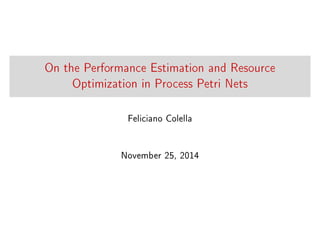
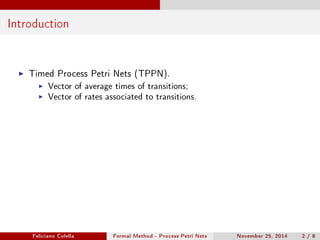
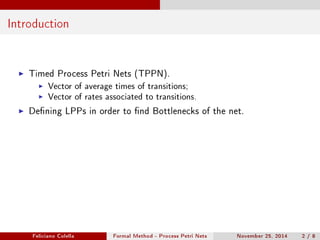
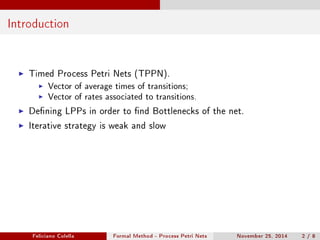
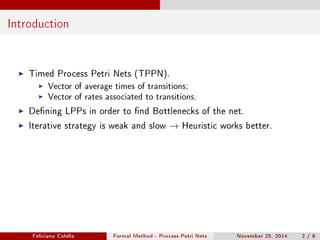
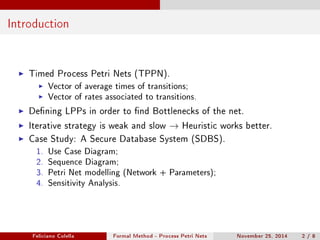
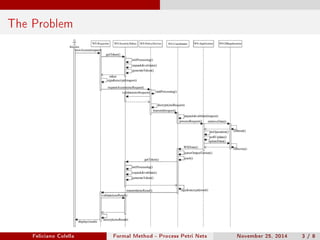
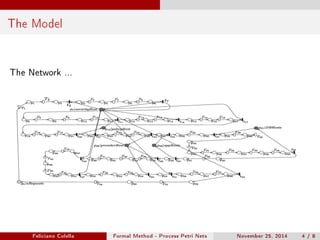
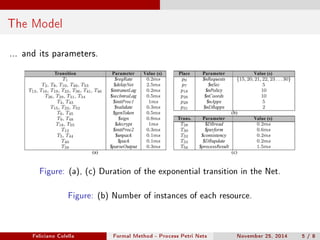
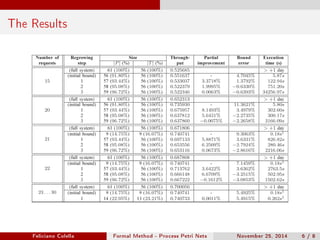
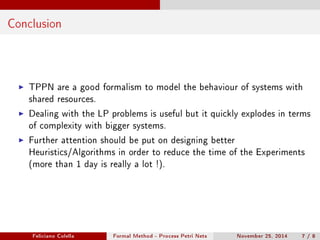

Ad
Recommended
SERENE 2014 Workshop: Paper "Advanced Modelling, Simulation and Verification ...
SERENE 2014 Workshop: Paper "Advanced Modelling, Simulation and Verification ...SERENEWorkshop
╠²
The document presents the Safecap project aimed at developing advanced modeling techniques for railway systems to optimize traffic regulation while ensuring safety and capacity. It discusses a formal approach to integrate various operational parameters and improve energy efficiency through real-time simulation and verification. Key objectives include supporting mixed traffic operations, optimizing traffic flow, and enhancing system resilience against disturbances.Model Based Hierarchical and Distributed Control of Discrete Event Robotic Sy...
Model Based Hierarchical and Distributed Control of Discrete Event Robotic Sy...Waqas Tariq
╠²
This paper proposes a model-based hierarchical and distributed control method for discrete event robotic systems using extended Petri nets. The approach allows for the consistent modeling, simulation, and control of complex robotic systems through a structured hierarchical design, enabling real-time coordination and communication between components. The extended Petri nets facilitate effective representation of events and states, addressing issues of concurrency, synchronization, and resource sharing inherent in such systems.Generalized Stochastic Petri Nets
Generalized Stochastic Petri NetsUmar Alharaky
╠²
This document introduces Generalized Stochastic Petri Nets (GSPNs). [1] GSPNs combine features of Petri Nets and stochastic processes. They contain both timed transitions with exponentially distributed random firing delays and immediate transitions with zero delay. [2] Immediate transitions have priority over timed transitions. GSPNs can model systems with both deterministic and stochastic behavior.Kuchnia polska
Kuchnia polskaSlow Food Youth
╠²
Prezentacja na IV warsztat: Kuchnia polska
Autorki:
Justyna Lorenc, Sonia Wontrucka
LO nr 40, ul.Foksal 11, Warszawa
An Operational Petri Net Semantics for the Join-Calculus
An Operational Petri Net Semantics for the Join-Calculussmennicke
╠²
The document presents an operational Petri net semantics for the join-calculus. It motivates the semantics by discussing distributed systems and prior work defining distributed properties using Petri nets. It then introduces the join-calculus and existing Petri net semantics. The key ingredients of the concurrent Petri net semantics are: a universe of places, a decomposition function mapping terms to places, and transition rules. Examples are provided to illustrate concurrency. Correctness is proven by showing bisimulation between join terms and their Petri net representations. The semantics enables applying Petri net tools and investigating distributed properties like distributability.Executable modeling and simulation of system software and processes
Executable modeling and simulation of system software and processesTom Mens
╠²
The document discusses executable modeling and simulation of system software and processes. It describes how modeling languages like statecharts, Petri nets, and BPMN can be used to model control software, business processes, and other complex systems. Models can then be simulated and analyzed to better understand problems, reduce complexity, detect errors early, and compare alternative solutions. Challenges discussed include providing better support for domain-specific modeling, model-based testing, and executable robot modeling.Transportation planning
Transportation planning Allaa Muhammad
╠²
Transportation planning involves moving people and goods from place to place. It applies planning techniques to facilitate mobility. The process includes identifying the situation, defining problems, finding solutions, evaluating alternatives, choosing a project, and building. It requires understanding contexts, specifying issues, creative problem-solving, considering multiple options, and implementing solutions while navigating political and logistical challenges. The overall goal is to improve transportation systems through a thorough planning methodology.ž┤ž©┌®┘ćŌĆī┘枦█ī ┘Šž¬ž▒█ī
ž┤ž©┌®┘ćŌĆī┘枦█ī ┘Šž¬ž▒█īMahdi Dolati
╠²
┘ģ┘鞦┘ä┘ć ž»ž▒ ┘ģ┘łž▒ž» ž┤ž©┌®┘ćŌĆī┘枦█ī ┘Šž¬ž▒█ī ž©ž¦ ž▒┘ł█ī┌®ž▒ž» žĄ┘łž▒█ī. ž»ž▒ ž¦█ī┘å ┘ģ┘鞦┘ä┘ć ž╣┘䞦┘ł┘ć ž©ž▒ ž┤ž©┌®┘ćŌĆī┘枦█ī ┘Šž¬ž▒█ī ┌®┘䞦ž│█ī┌® ž©┘ć ž┤ž©┌®┘ćŌĆī┘枦█ī ┘Šž¬ž▒█ī ž©ž¦ ž¦┘å┘łž¦ž╣ ┘ģž«ž¬┘ä┘ü █īž¦┘ä ┘ł ┘ć┘ģ┌å┘å█ī┘å ž┤ž©┌®┘ćŌĆī┘枦█ī ┘Šž¬ž▒█ī ž▓┘ģž¦┘åŌĆīž»ž¦ž▒ ┘Šž▒ž»ž¦ž«ž¬┘ć ┘ģ█īŌĆīž┤┘łž»Exploring Petri Net State Spaces
Exploring Petri Net State SpacesUniversit├żt Rostock
╠²
The document discusses the exploration of Petri net state spaces and the benefits of using dedicated analysis techniques, showcasing various applications and experiences with the tool Lola for state space generation and reduction. It highlights the implementation of Petri net semantics for BPEL, solutions for verifying large process models, and various reduction techniques like stubborn sets and linear algebra. The conclusion emphasizes the importance of using Petri nets for modeling and the effectiveness of combining reduction techniques for analysis.metrobus project rwp
metrobus project rwpMuhammad Usman
╠²
The Metro Bus project for twin cities in Pakistan began in March 2014 with an initial budget of Rs 34.80 billion but exceeded its budget, costing Rs 44.94 billion total. The project benefits a small portion of Pakistan's population of 200 million people. Given Pakistan's poor financial condition and high illiteracy rates, taking on more debt to fund such an expensive project is unwise when basic needs are not being met and countries like Pakistan are relying on international monetary organizations for survival. Resources would be better spent on priorities like education, healthcare, and infrastructure instead of luxury projects.Road and traffic control
Road and traffic controlBRS ENGINEERING
╠²
This document contains information about Ravindra Yadav, a first year mechanical engineering student. It discusses traffic engineering, factors affecting traffic such as road users, vehicles, roadways and environment. It covers traffic characteristics, studies, operation, planning, design, management and administration. Specific topics discussed include road user characteristics, vehicular characteristics, density, capacity, time headway and space headway. The document also discusses traffic regulation through devices like licenses, vehicle registration, transport authorities, speed limits and control devices. It describes different types of traffic signs used for regulation, warning and providing information.A petri-net
A petri-netOmar Al-Sabek
╠²
1) A Petri net is a graphical modeling tool used to represent systems with concurrent, asynchronous components. It consists of places, transitions, and arcs between them.
2) The document discusses using Petri nets to model resource sharing between two processors to avoid deadlocks. It defines deadlocks and describes the banker's algorithm for deadlock avoidance.
3) The banker's algorithm works by ensuring the system is always in a safe state where all processes can complete even if maximum resources are requested. It maintains data structures to track available, allocated, and needed resources.The Petri Net API - A collection of Petri net-related functions
The Petri Net API - A collection of Petri net-related functionsUniversit├żt Rostock
╠²
This document introduces the Petri Net API, a C++ library for working with Petri nets. The API was created to provide commonly used Petri net functionality while being performant and easy to integrate. It has seen widespread use, with over 25,000 lines of code from the API being used in 29 tools developed by 26 developers. The API facilitates development of Petri net-related software by encapsulating functionality in an accessible way.Petri nets by Barkatllah
Petri nets by BarkatllahBarkat Ullah
╠²
The document discusses Petri nets, which are a modeling language used to model distributed systems. Petri nets represent systems as bipartite graphs with places and transitions connected by arcs. Places represent states and transitions represent events that cause state changes. The movement of tokens between places denotes state changes triggered by the firing of transitions. Examples of using Petri nets to model chemical processes and disease processes are provided. Carl Adam Petri invented Petri nets in 1962 to describe chemical processes.Z specification
Z specificationFalguni Roy
╠²
This document describes how to specify an Android tourism application using the formal specification language Z. It defines schemas for entities like hotels, markets, restaurants, ATM booths, entertainment areas, and transport with variables and operations. It shows how to initialize variables, insert values, and display interfaces for each schema. The user schema ties it all together by initializing sets and functions, defining the application, and allowing the user to view detail information.A Feature-Complete Petri Net A Feature-Complete Petri Net Semantics for WS-BP...
A Feature-Complete Petri Net A Feature-Complete Petri Net Semantics for WS-BP...Universit├żt Rostock
╠²
The document presents a feature-complete petri net semantics for WS-BPEL 2.0, aimed at formally understanding and analyzing business processes implemented as web services. It details the formal model of open workflow nets and highlights new features and activities introduced in WS-BPEL 2.0. Additionally, it discusses the implications for future developments in WS-BPEL and the tools available for analysis and synthesis of processes.Petri Nets: Properties, Analysis and Applications
Petri Nets: Properties, Analysis and ApplicationsDr. Mohamed Torky
╠²
This document presents an agenda for a talk on Petri nets. It begins with an introduction to Petri nets that defines their structure, including places, transitions, tokens, and firing rules. It then discusses several analysis methods for Petri nets, including reachability trees, incidence matrices, and reduction rules. Next, it covers high-level Petri nets and colored Petri nets. The document concludes by mentioning an application of Petri nets to rumor detection and blocking in online social networks, and introduces orbital Petri nets as a promising approach.CS-438 WK13-15LEC25-30 Computer System Modeling.pdf
CS-438 WK13-15LEC25-30 Computer System Modeling.pdfMUHAMMADUSMANYOUSUF1
╠²
The document outlines the fundamentals of Petri nets (PNs) as graphical tools for modeling the performance of computer systems, emphasizing their capability to represent synchronization and resource contention. It covers various aspects of Petri nets, including their structure, dynamic behavior, and applications in modeling computer systems, specifically addressing concepts like reachability, reversibility, and properties such as liveness, safeness, boundedness, and conservation. The document further discusses practical examples and mathematical representations, including input/output functions through matrix analysis.Cb32492496
Cb32492496IJERA Editor
╠²
This document summarizes a research paper that proposes using Petri nets to model and schedule job shop manufacturing systems. It begins by introducing Petri nets and their use in modeling complex systems. It then discusses how timed Petri nets can be used to model manufacturing systems by associating delays with transitions. The document proceeds to define the general scheduling problem and job shop scheduling problem. It concludes by illustrating how Petri nets can be used to model and schedule a sample job shop scheduling problem by integrating modeling and optimization.Cb32492496
Cb32492496IJERA Editor
╠²
The document presents a study on job shop scheduling using timed Petri nets, highlighting the complexities of cyclic scheduling in manufacturing. It introduces a model that integrates both modeling and optimization to represent scheduling problems more effectively. The application of the timed Petri net is illustrated through examples, demonstrating its utility for various scheduling scenarios.Conceptual Fixture Design Method Based On Petri Net
Conceptual Fixture Design Method Based On Petri NetIJRES Journal
╠²
This paper presents a conceptual fixture design method based on Petri nets to enhance design processes for fixtures in manufacturing. It describes how to analyze, model, and simulate fixture design processes using Petri nets, improving efficiency and cost-effectiveness. The results demonstrate that this approach ensures high precision in fixture manufacturing and facilitates better management of product development dynamics.Petri Net or place/transition net Method
Petri Net or place/transition net MethodDaffodil International University
╠²
This document discusses the Petri net method. Petri nets are a diagramming tool used to model concurrent and synchronized systems. They consist of places and transitions, with places representing states and transitions representing changes between states. Places are circles and transitions are thick bars. Transitions fire to change the state of a Petri net, following a set of mathematical rules. The document provides examples of using Petri nets to model queuing systems.Modelling Multi-Component Predictive Systems as Petri Nets
Modelling Multi-Component Predictive Systems as Petri NetsManuel Mart├Łn
╠²
The document discusses the modeling of multi-component predictive systems (MCPS) using Petri nets, emphasizing their flexibility, reliability, and robustness in various industrial applications such as fault detection and process monitoring. It also explores automation methods for optimizing these systems with tools like Auto-Weka and emphasizes the importance of preprocessing data to ensure the accuracy of predictive models. The conclusion highlights future work aimed at improving the representation and adaptation of MCPS through advanced modeling techniques.all about petri netis model and simulation
all about petri netis model and simulationAssadLeo1
╠²
The document covers Petri nets which are mathematical and graphical tools for modeling discrete event dynamic systems. It introduces techniques for evaluating software and hardware systems, including simulation, deductive verification, and model checking. The document details the components of Petri nets, their firing rules, and applications in areas like concurrency, mutual exclusion, and resource allocation analysis.Visualising and Analysing Dynamic Business Processes using Petri nets
Visualising and Analysing Dynamic Business Processes using Petri netsMithileysh Sathiyanarayanan
╠²
1) The document proposes a novel approach to using mathematical formulas to revise business processes modeled with Petri nets. The goal is to reduce cost and cycle time by reducing the number of tasks needed to complete the process.
2) The approach generates alternative business process designs by excluding certain transitions in the Petri net model. Excluded transitions are evaluated based on minimizing duration.
3) Results show the proposed approach can efficiently optimize process attributes like cost and duration. It was able to reduce the duration of the case study process by 12.5% by removing unnecessary tasks.USE OF ADAPTIVE COLOURED PETRI NETWORK IN SUPPORT OF DECISIONMAKING
USE OF ADAPTIVE COLOURED PETRI NETWORK IN SUPPORT OF DECISIONMAKINGcsandit
╠²
This document discusses the use of Adaptive Coloured Petri Nets (ACPN) to enhance decision-making processes by integrating adaptive decision tables, allowing for dynamic incorporation of expert rules into network structures. It outlines the improvements offered by ACPNs over traditional decision tables and Petri nets, highlighting their potential in modeling complex problems in both engineering and administrative domains. The paper concludes that such integration facilitates better decision support and management practices within enterprises.Inside LoLA - Experiences from building a state space tool for place transiti...
Inside LoLA - Experiences from building a state space tool for place transiti...Universit├żt Rostock
╠²
LoLA is a state space tool for analyzing place/transition nets that was developed starting in 1998. It uses various reduction techniques like stubborn sets, symmetries, and linear algebra to combat state space explosion. LoLA has been applied to problems in areas like model checking, business process verification, and distributed systems. Its core data structures and algorithms keep processing costs low during operations like firing transitions and state space traversal.Continuous Systems To Discrete Event Systems
Continuous Systems To Discrete Event Systemsahmad bassiouny
╠²
This document summarizes different modeling and control approaches for continuous and discrete event systems. It discusses how Petri nets can be used to model discrete event systems and manufacturing processes. It also provides an example of using a Petri net to model a batch plant and analyzing its performance. Finally, it mentions how Petri nets can be combined with artificial intelligence search methods for scheduling.Model checking of time petri nets
Model checking of time petri netsMarwa Al-Rikaby
╠²
This document discusses model checking of time Petri nets (TPN). TPN extend ordinary Petri nets by associating time intervals with transitions, specifying minimum and maximum times for a transition to remain enabled before firing. The document outlines TPN semantics based on clocks or intervals, temporal logics like TCTL for specifying timed properties, and techniques for abstracting the generally infinite TPN state space into a finite representation to enable model checking of properties. Abstract states group markings by time variables and various abstractions aim to preserve linear or branching properties of the original state space.Colored petri nets theory and applications
Colored petri nets theory and applicationsAbu Hussein
╠²
This document discusses colored Petri nets (CP-nets) and their applications. CP-nets combine Petri nets with programming languages to model systems involving concurrency, communication, and resource sharing. They allow for simulation and formal verification. The document provides examples of CP-net applications in various domains including protocols, software, hardware, control systems, and military systems. It also describes how CP-net models can be used to automatically generate code for system implementations.More Related Content
Viewers also liked (8)
Exploring Petri Net State Spaces
Exploring Petri Net State SpacesUniversit├żt Rostock
╠²
The document discusses the exploration of Petri net state spaces and the benefits of using dedicated analysis techniques, showcasing various applications and experiences with the tool Lola for state space generation and reduction. It highlights the implementation of Petri net semantics for BPEL, solutions for verifying large process models, and various reduction techniques like stubborn sets and linear algebra. The conclusion emphasizes the importance of using Petri nets for modeling and the effectiveness of combining reduction techniques for analysis.metrobus project rwp
metrobus project rwpMuhammad Usman
╠²
The Metro Bus project for twin cities in Pakistan began in March 2014 with an initial budget of Rs 34.80 billion but exceeded its budget, costing Rs 44.94 billion total. The project benefits a small portion of Pakistan's population of 200 million people. Given Pakistan's poor financial condition and high illiteracy rates, taking on more debt to fund such an expensive project is unwise when basic needs are not being met and countries like Pakistan are relying on international monetary organizations for survival. Resources would be better spent on priorities like education, healthcare, and infrastructure instead of luxury projects.Road and traffic control
Road and traffic controlBRS ENGINEERING
╠²
This document contains information about Ravindra Yadav, a first year mechanical engineering student. It discusses traffic engineering, factors affecting traffic such as road users, vehicles, roadways and environment. It covers traffic characteristics, studies, operation, planning, design, management and administration. Specific topics discussed include road user characteristics, vehicular characteristics, density, capacity, time headway and space headway. The document also discusses traffic regulation through devices like licenses, vehicle registration, transport authorities, speed limits and control devices. It describes different types of traffic signs used for regulation, warning and providing information.A petri-net
A petri-netOmar Al-Sabek
╠²
1) A Petri net is a graphical modeling tool used to represent systems with concurrent, asynchronous components. It consists of places, transitions, and arcs between them.
2) The document discusses using Petri nets to model resource sharing between two processors to avoid deadlocks. It defines deadlocks and describes the banker's algorithm for deadlock avoidance.
3) The banker's algorithm works by ensuring the system is always in a safe state where all processes can complete even if maximum resources are requested. It maintains data structures to track available, allocated, and needed resources.The Petri Net API - A collection of Petri net-related functions
The Petri Net API - A collection of Petri net-related functionsUniversit├żt Rostock
╠²
This document introduces the Petri Net API, a C++ library for working with Petri nets. The API was created to provide commonly used Petri net functionality while being performant and easy to integrate. It has seen widespread use, with over 25,000 lines of code from the API being used in 29 tools developed by 26 developers. The API facilitates development of Petri net-related software by encapsulating functionality in an accessible way.Petri nets by Barkatllah
Petri nets by BarkatllahBarkat Ullah
╠²
The document discusses Petri nets, which are a modeling language used to model distributed systems. Petri nets represent systems as bipartite graphs with places and transitions connected by arcs. Places represent states and transitions represent events that cause state changes. The movement of tokens between places denotes state changes triggered by the firing of transitions. Examples of using Petri nets to model chemical processes and disease processes are provided. Carl Adam Petri invented Petri nets in 1962 to describe chemical processes.Z specification
Z specificationFalguni Roy
╠²
This document describes how to specify an Android tourism application using the formal specification language Z. It defines schemas for entities like hotels, markets, restaurants, ATM booths, entertainment areas, and transport with variables and operations. It shows how to initialize variables, insert values, and display interfaces for each schema. The user schema ties it all together by initializing sets and functions, defining the application, and allowing the user to view detail information.A Feature-Complete Petri Net A Feature-Complete Petri Net Semantics for WS-BP...
A Feature-Complete Petri Net A Feature-Complete Petri Net Semantics for WS-BP...Universit├żt Rostock
╠²
The document presents a feature-complete petri net semantics for WS-BPEL 2.0, aimed at formally understanding and analyzing business processes implemented as web services. It details the formal model of open workflow nets and highlights new features and activities introduced in WS-BPEL 2.0. Additionally, it discusses the implications for future developments in WS-BPEL and the tools available for analysis and synthesis of processes.A Feature-Complete Petri Net A Feature-Complete Petri Net Semantics for WS-BP...
A Feature-Complete Petri Net A Feature-Complete Petri Net Semantics for WS-BP...Universit├żt Rostock
╠²
Similar to Performance estimation with petri nets (17)
Petri Nets: Properties, Analysis and Applications
Petri Nets: Properties, Analysis and ApplicationsDr. Mohamed Torky
╠²
This document presents an agenda for a talk on Petri nets. It begins with an introduction to Petri nets that defines their structure, including places, transitions, tokens, and firing rules. It then discusses several analysis methods for Petri nets, including reachability trees, incidence matrices, and reduction rules. Next, it covers high-level Petri nets and colored Petri nets. The document concludes by mentioning an application of Petri nets to rumor detection and blocking in online social networks, and introduces orbital Petri nets as a promising approach.CS-438 WK13-15LEC25-30 Computer System Modeling.pdf
CS-438 WK13-15LEC25-30 Computer System Modeling.pdfMUHAMMADUSMANYOUSUF1
╠²
The document outlines the fundamentals of Petri nets (PNs) as graphical tools for modeling the performance of computer systems, emphasizing their capability to represent synchronization and resource contention. It covers various aspects of Petri nets, including their structure, dynamic behavior, and applications in modeling computer systems, specifically addressing concepts like reachability, reversibility, and properties such as liveness, safeness, boundedness, and conservation. The document further discusses practical examples and mathematical representations, including input/output functions through matrix analysis.Cb32492496
Cb32492496IJERA Editor
╠²
This document summarizes a research paper that proposes using Petri nets to model and schedule job shop manufacturing systems. It begins by introducing Petri nets and their use in modeling complex systems. It then discusses how timed Petri nets can be used to model manufacturing systems by associating delays with transitions. The document proceeds to define the general scheduling problem and job shop scheduling problem. It concludes by illustrating how Petri nets can be used to model and schedule a sample job shop scheduling problem by integrating modeling and optimization.Cb32492496
Cb32492496IJERA Editor
╠²
The document presents a study on job shop scheduling using timed Petri nets, highlighting the complexities of cyclic scheduling in manufacturing. It introduces a model that integrates both modeling and optimization to represent scheduling problems more effectively. The application of the timed Petri net is illustrated through examples, demonstrating its utility for various scheduling scenarios.Conceptual Fixture Design Method Based On Petri Net
Conceptual Fixture Design Method Based On Petri NetIJRES Journal
╠²
This paper presents a conceptual fixture design method based on Petri nets to enhance design processes for fixtures in manufacturing. It describes how to analyze, model, and simulate fixture design processes using Petri nets, improving efficiency and cost-effectiveness. The results demonstrate that this approach ensures high precision in fixture manufacturing and facilitates better management of product development dynamics.Petri Net or place/transition net Method
Petri Net or place/transition net MethodDaffodil International University
╠²
This document discusses the Petri net method. Petri nets are a diagramming tool used to model concurrent and synchronized systems. They consist of places and transitions, with places representing states and transitions representing changes between states. Places are circles and transitions are thick bars. Transitions fire to change the state of a Petri net, following a set of mathematical rules. The document provides examples of using Petri nets to model queuing systems.Modelling Multi-Component Predictive Systems as Petri Nets
Modelling Multi-Component Predictive Systems as Petri NetsManuel Mart├Łn
╠²
The document discusses the modeling of multi-component predictive systems (MCPS) using Petri nets, emphasizing their flexibility, reliability, and robustness in various industrial applications such as fault detection and process monitoring. It also explores automation methods for optimizing these systems with tools like Auto-Weka and emphasizes the importance of preprocessing data to ensure the accuracy of predictive models. The conclusion highlights future work aimed at improving the representation and adaptation of MCPS through advanced modeling techniques.all about petri netis model and simulation
all about petri netis model and simulationAssadLeo1
╠²
The document covers Petri nets which are mathematical and graphical tools for modeling discrete event dynamic systems. It introduces techniques for evaluating software and hardware systems, including simulation, deductive verification, and model checking. The document details the components of Petri nets, their firing rules, and applications in areas like concurrency, mutual exclusion, and resource allocation analysis.Visualising and Analysing Dynamic Business Processes using Petri nets
Visualising and Analysing Dynamic Business Processes using Petri netsMithileysh Sathiyanarayanan
╠²
1) The document proposes a novel approach to using mathematical formulas to revise business processes modeled with Petri nets. The goal is to reduce cost and cycle time by reducing the number of tasks needed to complete the process.
2) The approach generates alternative business process designs by excluding certain transitions in the Petri net model. Excluded transitions are evaluated based on minimizing duration.
3) Results show the proposed approach can efficiently optimize process attributes like cost and duration. It was able to reduce the duration of the case study process by 12.5% by removing unnecessary tasks.USE OF ADAPTIVE COLOURED PETRI NETWORK IN SUPPORT OF DECISIONMAKING
USE OF ADAPTIVE COLOURED PETRI NETWORK IN SUPPORT OF DECISIONMAKINGcsandit
╠²
This document discusses the use of Adaptive Coloured Petri Nets (ACPN) to enhance decision-making processes by integrating adaptive decision tables, allowing for dynamic incorporation of expert rules into network structures. It outlines the improvements offered by ACPNs over traditional decision tables and Petri nets, highlighting their potential in modeling complex problems in both engineering and administrative domains. The paper concludes that such integration facilitates better decision support and management practices within enterprises.Inside LoLA - Experiences from building a state space tool for place transiti...
Inside LoLA - Experiences from building a state space tool for place transiti...Universit├żt Rostock
╠²
LoLA is a state space tool for analyzing place/transition nets that was developed starting in 1998. It uses various reduction techniques like stubborn sets, symmetries, and linear algebra to combat state space explosion. LoLA has been applied to problems in areas like model checking, business process verification, and distributed systems. Its core data structures and algorithms keep processing costs low during operations like firing transitions and state space traversal.Continuous Systems To Discrete Event Systems
Continuous Systems To Discrete Event Systemsahmad bassiouny
╠²
This document summarizes different modeling and control approaches for continuous and discrete event systems. It discusses how Petri nets can be used to model discrete event systems and manufacturing processes. It also provides an example of using a Petri net to model a batch plant and analyzing its performance. Finally, it mentions how Petri nets can be combined with artificial intelligence search methods for scheduling.Model checking of time petri nets
Model checking of time petri netsMarwa Al-Rikaby
╠²
This document discusses model checking of time Petri nets (TPN). TPN extend ordinary Petri nets by associating time intervals with transitions, specifying minimum and maximum times for a transition to remain enabled before firing. The document outlines TPN semantics based on clocks or intervals, temporal logics like TCTL for specifying timed properties, and techniques for abstracting the generally infinite TPN state space into a finite representation to enable model checking of properties. Abstract states group markings by time variables and various abstractions aim to preserve linear or branching properties of the original state space.Colored petri nets theory and applications
Colored petri nets theory and applicationsAbu Hussein
╠²
This document discusses colored Petri nets (CP-nets) and their applications. CP-nets combine Petri nets with programming languages to model systems involving concurrency, communication, and resource sharing. They allow for simulation and formal verification. The document provides examples of CP-net applications in various domains including protocols, software, hardware, control systems, and military systems. It also describes how CP-net models can be used to automatically generate code for system implementations.Pragmatic model checking: from theory to implementations
Pragmatic model checking: from theory to implementationsUniversit├żt Rostock
╠²
The document discusses pragmatic model checking, including theoretical foundations, practical implementations, and optimization techniques to develop effective model checkers. It emphasizes the challenges of state explosion in complex systems, illustrated by an example involving IBM's business process modeling, and introduces concepts such as partial order reduction, symmetry reduction, and state compression as strategies to manage this complexity. Furthermore, it highlights the importance of pragmatism in achieving results amidst the inherent complexity of model checking.petri-nets: definition and its application
petri-nets: definition and its applicationnicholas507559
╠²
The document provides an overview of Petri nets, including their definition, application, and basic properties such as sequential execution, concurrency, and conflict. It explains how Petri nets model network-based systems with discrete flows and illustrates concepts with examples, including scenarios related to a restaurant and a vending machine. The document also touches on the historical development of Petri nets and the introduction of time in their analysis.Verification with LoLA: 4 Using LoLA
Verification with LoLA: 4 Using LoLAUniversit├żt Rostock
╠²
LoLA is a tool for verifying properties of Petri nets. This document discusses how to:
1. Choose and manage LoLA configurations to optimally verify properties.
2. Ask the right verification questions in a specific, modular way to efficiently verify properties.
3. Optimize Petri net modeling to take advantage of LoLA's reduction techniques and scale verification.
4. Employ scripts and makefiles to automate calling LoLA and analyzing results.
5. Integrate calling LoLA from other tools using UNIX streams for modular verification.Inside LoLA - Experiences from building a state space tool for place transiti...
Inside LoLA - Experiences from building a state space tool for place transiti...Universit├żt Rostock
╠²
Ad
Recently uploaded (20)
Science Experiment: Properties of Water.pptx
Science Experiment: Properties of Water.pptxmarionrada1985
╠²
Different experiments to know the properties of waterThe scientific heritage No 162 (162) (2025)
The scientific heritage No 162 (162) (2025)The scientific heritage
╠²
The scientific heritage No 162 (162) (2025)Pneumonia Presentation for CPG Review and Mastery
Pneumonia Presentation for CPG Review and MasteryJayricDepalobos
╠²
Pneumonia Presentation for Internal Medicine DepartmentInvestigatory_project Topic:-effect of electrolysis in solar desalination .pdf
Investigatory_project Topic:-effect of electrolysis in solar desalination .pdfshubham997ku
╠²
Cbse class 12. chemistry investigatory project THE CIRCULATORY SYSTEM GRADE 9 SCIENCE.pptx
THE CIRCULATORY SYSTEM GRADE 9 SCIENCE.pptxroselyncatacutan
╠²
The Circulatory System Grade 9 Science Quarter 1 Week 1How Psychology Can Power Product Decisions: A Human-Centered Blueprint- Shray...
How Psychology Can Power Product Decisions: A Human-Centered Blueprint- Shray...ShrayasiRoy2
╠²
In an era where users are bombarded with endless choices, capturing attention and driving meaningful engagement isn't just about building features ŌĆö it's about understanding what drives human behavior at its core. This presentation offers a deep dive into how psychological principles can inform smarter, more intuitive product decisions. ItŌĆÖs not just theory ŌĆö itŌĆÖs a hands-on blueprint for applying human-centered thinking at every stage of product development.
Grounded in behavioral science, consumer psychology, and cognitive design, this deck unpacks the key psychological drivers behind user motivation, decision-making, emotional engagement, and habit formation. From attention economics and dopamine-driven interactions to trust cues, loss aversion, and the paradox of choice ŌĆö you'll see how to harness what the mind naturally does to build digital products people donŌĆÖt just useŌĆ” they return to, talk about, and even advocate for.
WeŌĆÖll explore:
Cognitive biases that shape user perception and choices ŌĆö and how to use them to your advantage without crossing ethical lines.
Emotional design principles that build trust, trigger desire, and turn features into feelings.
User behavior loops that build stickiness, deepen retention, and create emotional investments.
Psychological friction ŌĆö when to reduce it for conversion, and when to add it for intentionality.
Dark patterns vs. ethical persuasion ŌĆö the thin line between influence and manipulation.
A/B testing with a psychological lens ŌĆö learning not just what works, but why it works.
This is more than UX research or product marketing fluff. ItŌĆÖs a call to build with empathy, backed by science, and sharpened by real-world product thinking. Whether youŌĆÖre shaping onboarding flows, gamifying engagement, designing pricing models, or rethinking retention strategies ŌĆö this deck will arm you with a new lens: the human mind.
Perfect for product managers, growth strategists, UX designers, behavioral scientists, and anyone serious about building products that resonate, retain, and inspire action.
Because at the heart of every great productŌĆ” is a human.
LetŌĆÖs start building for the brain ŌĆö not just the screen.Impact of Network Topologies on Blockchain Performance
Impact of Network Topologies on Blockchain Performancevschiavoni
╠²
Best Student Paper Award at ACM DEBS 2025.
Paper here:
https://dl.acm.org/doi/10.1145/3701717.3730540
Since blockchains are increasingly adopted in real-world applications, it is of paramount importance to evaluate their performance across diverse scenarios. Although the network infrastructure plays a fundamental role, its impact on performance remains largely unexplored. Some studies evaluate blockchain in cloud environments, but this approach is costly and difficult to reproduce. We propose a cost-effective and reproducible environment that supports both cluster-based setups and emulation capabilities and allows the underlying network topology to be easily modified. We evaluate five industry-grade blockchains ŌĆō Algorand, Diem, Ethereum, Quorum, and Solana ŌĆō across five network topologies ŌĆō fat-tree, full mesh, hypercube, scale-free, and torus ŌĆō and different realistic workloads ŌĆō smart contract requests and transfer transactions. Our benchmark framework, Lilith, shows that full mesh, hypercube, and torus topologies improve blockchain performance under heavy workloads. Algorand and Diem perform consistently across the considered topologies, while Ethereum remains robust but slower.Role of Glutamate, glutamine and Alanine in Transport of Ammonia in Tissues
Role of Glutamate, glutamine and Alanine in Transport of Ammonia in TissuesTayyab
╠²
This slide explains the roles of Glutamate, Glutamine, and Alanine in safely transporting toxic ammonia from tissues to the liver and kidneys, where it is detoxified or excreted."MOLD -GENERAL CHARACTERISTICS AND CLASSIFICATION
MOLD -GENERAL CHARACTERISTICS AND CLASSIFICATIONaparnamp966
╠²
This is a brief note on types of organism on food with special focus on molds. This includes their general characteristics, spores; their classification, mycotoxins, and how the molds affect food. GBSN__Unit 2 - Control of Microorganisms
GBSN__Unit 2 - Control of MicroorganismsAreesha Ahmad
╠²
Microbiology for Nursing students - According to New PNC course curriculum - 2025
How Psychology Can Power Product Decisions: A Human-Centered Blueprint- Shray...
How Psychology Can Power Product Decisions: A Human-Centered Blueprint- Shray...ShrayasiRoy
╠²
In an era where users are bombarded with endless choices, capturing attention and driving meaningful engagement isn't just about building features ŌĆö it's about understanding what drives human behavior at its core. This presentation offers a deep dive into how psychological principles can inform smarter, more intuitive product decisions. ItŌĆÖs not just theory ŌĆö itŌĆÖs a hands-on blueprint for applying human-centered thinking at every stage of product development.
Grounded in behavioral science, consumer psychology, and cognitive design, this deck unpacks the key psychological drivers behind user motivation, decision-making, emotional engagement, and habit formation. From attention economics and dopamine-driven interactions to trust cues, loss aversion, and the paradox of choice ŌĆö you'll see how to harness what the mind naturally does to build digital products people donŌĆÖt just useŌĆ” they return to, talk about, and even advocate for.
WeŌĆÖll explore:
Cognitive biases that shape user perception and choices ŌĆö and how to use them to your advantage without crossing ethical lines.
Emotional design principles that build trust, trigger desire, and turn features into feelings.
User behavior loops that build stickiness, deepen retention, and create emotional investments.
Psychological friction ŌĆö when to reduce it for conversion, and when to add it for intentionality.
Dark patterns vs. ethical persuasion ŌĆö the thin line between influence and manipulation.
A/B testing with a psychological lens ŌĆö learning not just what works, but why it works.
This is more than UX research or product marketing fluff. ItŌĆÖs a call to build with empathy, backed by science, and sharpened by real-world product thinking. Whether youŌĆÖre shaping onboarding flows, gamifying engagement, designing pricing models, or rethinking retention strategies ŌĆö this deck will arm you with a new lens: the human mind.
Perfect for product managers, growth strategists, UX designers, behavioral scientists, and anyone serious about building products that resonate, retain, and inspire action.
Because at the heart of every great productŌĆ” is a human.
LetŌĆÖs start building for the brain ŌĆö not just the screen.An Analysis Of The Pearl Short Story By John Steinbeck
An Analysis Of The Pearl Short Story By John SteinbeckBillyDarmawan3
╠²
John Steinbeck Popular Short Story
The Pearl adalah sebuah novella yang ditulis oleh John Steinbeck yang mengisahkan perjuangan seorang nelayan miskin bernama Kino dan istrinya, Juana, yang hidup sederhana di sebuah desa kecil Meksiko. Suatu hari, Kino menemukan sebuah mutiara raksasa ŌĆö "the Pearl of the World" ŌĆö yang diyakini akan mengubah nasib mereka.
Namun, alih-alih membawa kebahagiaan, mutiara itu justru menimbulkan keserakahan, kekerasan, dan penderitaan. Masyarakat di sekitarnya mulai menunjukkan niat jahat, dan bahkan keluarga Kino sendiri terjebak dalam konflik batin antara harapan dan kehancuran. Pada akhirnya, The Pearl menjadi simbol ironi: sesuatu yang tampak sebagai berkah berubah menjadi kutukan.
Melalui cerita ini, Steinbeck mengeksplorasi tema keserakahan, harapan, kemiskinan, dan ketimpangan sosial. Dengan gaya narasi yang lugas namun penuh makna simbolik, The Pearl menjadi refleksi tajam tentang sifat manusia dan dampak tragis dari keinginan yang tak terkendali.
Matt Ridley: Economic Evolution and Ideas that have Sex
Matt Ridley: Economic Evolution and Ideas that have SexConservative Institute / Konzervat├Łvny in┼Ītit├║t M. R. ┼Ātef├Īnika
╠²
Matt Ridley is a British independent science popularizer, journalist, entrepreneur, and author of several bestselling books, for which he has received numerous awards. He focuses primarily on the economic, biological, and environmental dimensions of the spontaneous functioning and advancement of human society. Death in Sleep Apnea: Who and How It Kills
Death in Sleep Apnea: Who and How It KillsRichard Castriotta
╠²
Evaluation of mortality in obstructive sleep apnea.Matt Ridley: Economic Evolution and Ideas that have Sex
Matt Ridley: Economic Evolution and Ideas that have SexConservative Institute / Konzervat├Łvny in┼Ītit├║t M. R. ┼Ātef├Īnika
╠²
Ad
Performance estimation with petri nets
- 1. On the Performance Estimation and Resource Optimization in Process Petri Nets Feliciano Colella November 25, 2014
- 2. Introduction I Timed Process Petri Nets (TPPN). I Vector of average times of transitions; I Vector of rates associated to transitions. Feliciano Colella Formal Method - Process Petri Nets November 25, 2014 2 / 8
- 3. Introduction I Timed Process Petri Nets (TPPN). I Vector of average times of transitions; I Vector of rates associated to transitions. I Dening LPPs in order to nd Bottlenecks of the net. Feliciano Colella Formal Method - Process Petri Nets November 25, 2014 2 / 8
- 4. Introduction I Timed Process Petri Nets (TPPN). I Vector of average times of transitions; I Vector of rates associated to transitions. I Dening LPPs in order to nd Bottlenecks of the net. I Iterative strategy is weak and slow Feliciano Colella Formal Method - Process Petri Nets November 25, 2014 2 / 8
- 5. Introduction I Timed Process Petri Nets (TPPN). I Vector of average times of transitions; I Vector of rates associated to transitions. I Dening LPPs in order to nd Bottlenecks of the net. I Iterative strategy is weak and slow ! Heuristic works better. Feliciano Colella Formal Method - Process Petri Nets November 25, 2014 2 / 8
- 6. Introduction I Timed Process Petri Nets (TPPN). I Vector of average times of transitions; I Vector of rates associated to transitions. I Dening LPPs in order to nd Bottlenecks of the net. I Iterative strategy is weak and slow ! Heuristic works better. I Case Study: A Secure Database System (SDBS). 1. Use Case Diagram; 2. Sequence Diagram; 3. Petri Net modelling (Network + Parameters); 4. Sensitivity Analysis. Feliciano Colella Formal Method - Process Petri Nets November 25, 2014 2 / 8
- 7. The Problem Feliciano Colella Formal Method - Process Petri Nets November 25, 2014 3 / 8
- 8. The Model The Network ... Feliciano Colella Formal Method - Process Petri Nets November 25, 2014 4 / 8
- 9. The Model ... and its parameters. Figure: (a), (c) Duration of the exponential transition in the Net. Figure: (b) Number of instances of each resource. Feliciano Colella Formal Method - Process Petri Nets November 25, 2014 5 / 8
- 10. The Results Feliciano Colella Formal Method - Process Petri Nets November 25, 2014 6 / 8
- 11. Conclusion I TPPN are a good formalism to model the behaviour of systems with shared resources. I Dealing with the LP problems is useful but it quickly explodes in terms of complexity with bigger systems. I Further attention should be put on designing better Heuristics/Algorithms in order to reduce the time of the Experiments (more than 1 day is really a lot !). Feliciano Colella Formal Method - Process Petri Nets November 25, 2014 7 / 8
- 12. Thank you for the attention. Feliciano Colella Formal Method - Process Petri Nets November 25, 2014 8 / 8
